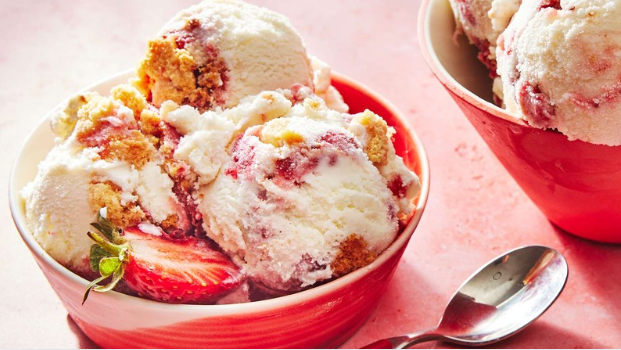Ice Cream Has Taken Over Dessert Menus

Ice cream, once a simple summer treat, has evolved into a culinary juggernaut, dominating dessert menus across the globe. From high-end restaurants to casual eateries, this frozen delight has transcended its nostalgic roots to become a versatile, innovative, and universally beloved dessert. Its rise reflects changing consumer preferences, advancements in culinary techniques, and a cultural shift toward indulgence and creativity. This article explores how ice cream has claimed its throne on dessert menus, examining its historical context, modern innovations, and the factors driving its ubiquity.
A Brief History of Ice Cream’s Ascendancy
Ice cream’s journey to dessert menu stardom began centuries ago. While its origins are debated, early versions of frozen desserts date back to ancient China, where emperors enjoyed fruit-flavored ices. By the 17th century, European aristocracy savored creamy concoctions made with milk and sugar, and by the 19th century, ice cream became more accessible thanks to advancements in refrigeration and churning technology. In the United States, ice cream parlors proliferated in the early 20th century, cementing its status as a nostalgic treat tied to summer fairs and family outings.
However, it wasn’t until the late 20th and early 21st centuries that ice cream began its takeover of dessert menus. The rise of artisanal food movements, coupled with a growing emphasis on local and high-quality ingredients, transformed ice cream from a mass-produced novelty into a canvas for culinary creativity. Chefs began experimenting with bold flavors, unconventional pairings, and sophisticated presentations, elevating ice cream to a starring role in fine dining and casual settings alike.
The Artisanal Ice Cream Boom
The artisanal ice cream movement, which gained momentum in the early 2000s, played a pivotal role in ice cream’s dominance. Small-batch producers like Jeni’s Splendid Ice Creams, Salt & Straw, and Ample Hills Creamery redefined the dessert by prioritizing quality ingredients and inventive flavors. Instead of relying on artificial stabilizers or flavorings, these brands used fresh, local produce, house-made mix-ins, and creative techniques to craft ice creams that felt personal and luxurious.
Flavors like olive oil, lavender-honey, and miso caramel began appearing on menus, appealing to food-savvy consumers eager for novel experiences. Artisanal ice cream shops didn’t just sell scoops; they offered stories—sourcing strawberries from nearby farms, collaborating with local breweries for beer-infused flavors, or reviving heirloom recipes. This focus on craftsmanship and narrative resonated with diners, who began to see ice cream as more than a childhood treat but as a sophisticated dessert worthy of a dedicated menu section.
Restaurants quickly followed suit. By the 2010s, upscale establishments from New York to Tokyo were featuring house-made ice creams, often crafted by pastry chefs with Michelin-star pedigrees. These desserts weren’t just afterthoughts but showstoppers, paired with complementary elements like caramelized fruit, edible flowers, or savory crumbles. The artisanal boom also democratized ice cream, as casual eateries and food trucks began offering their own spins, from soft-serve swirls to nitrogen-frozen creations.
Versatility: Ice Cream’s Secret Weapon
One of ice cream’s greatest strengths is its versatility. It can be a standalone dessert, a component in complex plated dishes, or a base for innovative hybrids. This adaptability has made it a favorite among chefs and restaurateurs looking to cater to diverse palates. Ice cream can be molded, layered, sandwiched, or even grilled, offering endless possibilities for presentation and flavor.
For example, ice cream sandwiches have become a dessert menu staple, with restaurants like The Baked Bear and Coolhaus offering customizable options featuring gourmet cookies and unexpected fillings. Affogatos, where a scoop of ice cream is “drowned” in espresso, have surged in popularity, blending the creamy and the caffeinated for a sophisticated yet approachable treat. Ice cream cakes, once reserved for birthdays, are now reimagined with layers of mousse, ganache, or seasonal fruits, appearing on menus at places like Milk Bar.
Soft-serve, too, has undergone a renaissance. Once relegated to fast-food chains, it’s now a darling of trendy eateries, swirled into Instagram-worthy cones with toppings like matcha powder, gold leaf, or charcoal dust. Chains like Soft Swirls and independent shops have capitalized on this trend, offering flavors like ube, black sesame, or cereal milk that cater to adventurous eaters. This versatility ensures ice cream’s presence on menus year-round, not just during summer months.
Cultural and Social Media Influence
Ice cream’s takeover owes much to its photogenic appeal and social media’s amplifying effect. In the age of Instagram and TikTok, desserts must be visually striking, and ice cream delivers. Vibrant scoops, towering sundaes, and artfully drizzled toppings are tailor-made for viral posts. Establishments like Morgenstern’s Finest Ice Cream in New York or Gelato Messina in Australia have become pilgrimage sites for food influencers, whose photos drive foot traffic and menu trends.
The “unicorn food” trend of the mid-2010s, with its pastel swirls and glittery toppings, propelled ice cream into the spotlight. Even as trends shifted toward more minimalist aesthetics, ice cream adapted, with sleek black cones or elegantly plated scoops maintaining its visual allure. Social media also democratized recipe-sharing, with home cooks and chefs alike posting tutorials for no-churn ice creams or liquid nitrogen techniques, further fueling public fascination.
Moreover, ice cream taps into nostalgia, a powerful emotional driver. For many, it evokes memories of childhood summers or family traditions, making it a comforting choice in uncertain times. During the COVID-19 pandemic, ice cream sales surged as people sought affordable indulgences, and restaurants leaned into takeout-friendly pints and delivery options. This emotional resonance, combined with its visual appeal, has cemented ice cream’s cultural dominance.
Global Flavors and Inclusivity
Ice cream’s global appeal has also contributed to its menu takeover. As dining becomes more cosmopolitan, chefs draw inspiration from international cuisines, infusing ice cream with flavors like Thai tea, mango lassi, or horchata. In cities like Los Angeles and London, dessert menus feature kulfi-inspired ice creams or mochi-wrapped scoops, reflecting diverse culinary traditions.
Inclusivity has further boosted ice cream’s popularity. Vegan and dairy-free options, made with coconut, almond, or oat milk, have exploded in popularity, catering to plant-based diets without sacrificing flavor. Brands like Van Leeuwen and Ben & Jerry’s offer non-dairy lines that rival their traditional counterparts, while restaurants incorporate sorbets and gelatos for lactose-intolerant diners. Gluten-free and low-sugar options also ensure ice cream’s accessibility, making it a dessert that nearly everyone can enjoy.
Innovations in Technique and Presentation
Culinary innovation has elevated ice cream beyond the scoop. Chefs now use techniques like liquid nitrogen for instant freezing, resulting in ultra-smooth textures. Others employ sous-vide to infuse flavors like rosemary or bacon into the base, creating complex profiles. Molecular gastronomy has introduced ice cream “caviar” or spherified scoops, adding a playful element to fine dining.
Presentation is equally transformative. At restaurants like Alinea or Eleven Madison Park, ice cream might arrive in sculptural forms, frozen tableside, or paired with unexpected elements like smoked salt or olive oil drizzle. Pop-up shops and festivals showcase ice cream in waffle tacos, rolled Thai-style, or even fried, pushing the boundaries of texture and format. These innovations keep ice cream fresh and exciting, ensuring its staying power on menus.
Ice Cream as a Year-Round Staple
While ice cream was once a seasonal treat, its presence on dessert menus is now year-round. Restaurants have embraced seasonal flavors to keep offerings dynamic—think pumpkin spice in fall or peppermint mocha in winter. Indoor dining and heated patios have also made ice cream viable in colder months, while delivery services like Uber Eats and DoorDash ensure access to pints and cones anytime.
The rise of “ice cream for breakfast” concepts, like cereal milk ice cream or waffle cone sundaes, has further blurred the lines between dessert and other meals. Cafés and bakeries now pair ice cream with waffles, doughnuts, or croissants, creating indulgent hybrids that appeal to all-day diners. This shift reflects a broader trend toward permissiveness in dining, where indulgence is celebrated at any hour.
Challenges and Sustainability
Despite its dominance, ice cream faces challenges. The artisanal movement, while celebrated, can be cost-prohibitive for smaller establishments, as high-quality ingredients and labor-intensive processes drive up prices. Supply chain issues, particularly for dairy and exotic ingredients, have also impacted production, especially post-pandemic. Additionally, the environmental footprint of dairy farming has raised concerns, pushing some producers toward sustainable practices or plant-based alternatives.
Restaurants are responding by prioritizing local sourcing and eco-friendly packaging. Some, like Salt & Straw, partner with regenerative farms, while others experiment with lab-grown dairy to reduce environmental impact. These efforts align with consumer demand for sustainability, ensuring ice cream remains a guilt-free pleasure.
The Future of Ice Cream on Dessert Menus
Looking ahead, ice cream’s reign shows no signs of slowing. Advances in food tech, like 3D-printed ice cream or AI-designed flavor profiles, promise to push boundaries further. Health-conscious options, such as protein-packed or probiotic-infused ice creams, are gaining traction, appealing to wellness-focused diners. Meanwhile, global fusion flavors—like miso caramel or yuzu sorbet—will continue to reflect culinary diversity.
Ice cream’s ability to balance nostalgia with innovation makes it a uniquely enduring dessert. Whether served in a classic cone or as part of a deconstructed fine-dining dish, it resonates with diners of all ages and backgrounds. Its adaptability ensures it can evolve with trends, from hyper-local ingredients to immersive dining experiences.
Conclusion
Ice cream’s takeover of dessert menus is a testament to its versatility, emotional resonance, and culinary potential. From artisanal shops to Michelin-starred restaurants, it has proven itself a canvas for creativity, a vehicle for global flavors, and a source of universal joy. As chefs continue to innovate and consumers embrace indulgence, ice cream will remain a dessert menu mainstay, delighting palates and sparking memories for years to come.



